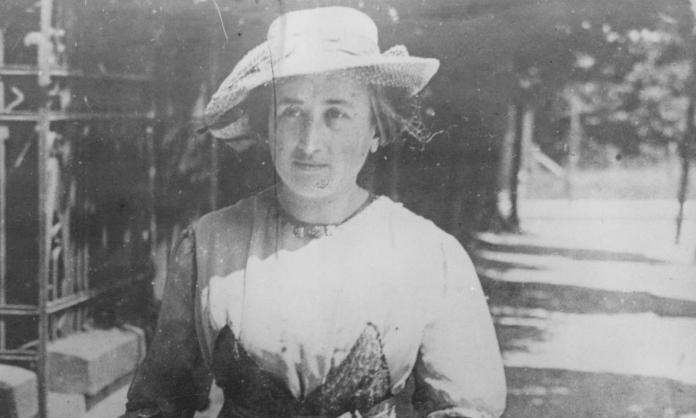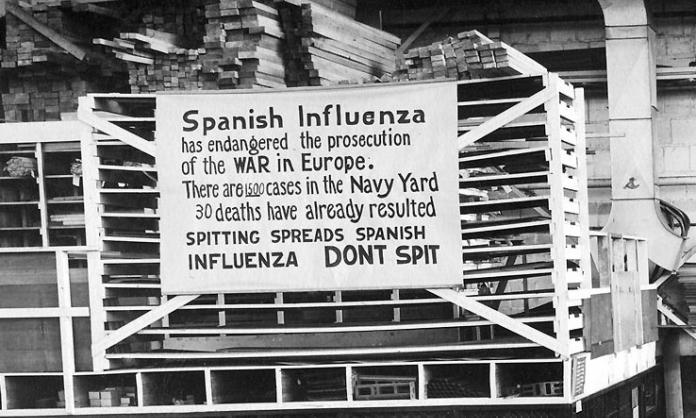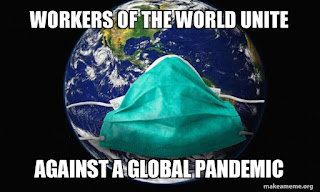Sandra Bloodworth 01 May 2020 RED FLAG AU.

The despicable Scott Morrison and Donald Trump invoke the macabre metaphor of war to describe this crisis we are living through. UN secretary-general Antonio Guterres says: “We are at war with a virus…This war needs a war-time plan to fight it.” That metaphor is a deliberate ploy. What better way to encourage workers and the poor to accept the inequalities intrinsic to capitalism? Morrison wants us to believe that now “there are no more unions or bosses” – and Sally McManus, Secretary of the Australian Countil of Trade Unions, sings Morrison’s praises because he deigns to speak to her.
Rosa Luxemburg, a revolutionary opposition leader in the German Social Democratic party – a massive, more radical version of our Labor Party – savagely denounced the party leaders’ capitulation to just such appeals when the actual World War I broke out. Almost the entire leadership ditched their former anti-war stance, invoking the rhetoric of a nation united as they urged workers to go off to the slaughter of war.
Luxemburg’s passionate reply to their betrayals, summed up her pamphlet, The Crisis in the German Social Democracy. It’s known as the “Junius Pamphlet” because she published it under that pseudonym, while she was imprisoned for antiwar activism. Luxemburg’s words echo across the century. It should be our reply today to the Labor Party and trade union leaders. Just substitute pandemic and economic crisis for war:
“What then has changed [since] the war broke out? Have private property, capitalist exploitation and class rule ceased to exist? Or have the propertied classes in a spell of patriotic fervour declared: in view of the needs of the war we hereby turn over the means of production, the earth, the factories and the mills therein, into the possession of the people?
“Have they relinquished the right to make profits out of these possessions? Have they set aside all political privileges, will they sacrifice them upon the altar of the fatherland, now that it is in danger? It is, to say the least, a rather naive hypothesis, and sounds almost like a story from a kindergarten primer.”
Labor politicians are grovelling to sit in Morrison’s “national cabinet” where “war time plans” to protect big business interests are crafted. Our union leaders have, by and large, rushed to join the bosses in demanding sacrifices from their members such as wage cuts while Morrison prepares “reforms” to further destroy union rights.
So Luxemburg’s fury resonates:
“The cessation of the class struggle was, therefore, a deplorably one-sided affair. While capitalist oppression and exploitation, the worst enemies of the working class, remain; socialist and labour union leaders have generously delivered the working class, without a struggle, into the hands of the enemy for the duration of the war. While the ruling classes are fully armed with the property and supremacy rights, the working class, at the advice of the social democracy, has laid down its arms.”
The obsequious Anthony Albanese says “Cooperation is always better than conflict”. Luxemburg’s words should be hurled in his face:
“In refuting the existence of the class struggle, the social democracy [read Labor Party] has denied the very basis of its own existence... What role could it expect to play in the war, once having sacrificed the class struggle...? The social democracy has destroyed its mission...as an active political party, as a representative of working-class politics. It has thrown aside the most important weapon it possessed, the power of criticism of the war from the peculiar point of view of the working class. Its only mission now is to play the role of the gendarme over the working class.”
As long as capitalism exists we will revisit similar crises, and every time governments and corporate bosses will demand that workers, the poor and oppressed pay the price. Big business is sacrosanct, demanding and getting huge bail out packages. But hundreds of thousands being thrown into unemployment are facing the prospect of living on $40 a day in September, and millions are eking out a life with no income. And every time, the demands for sacrifice by our side are backed up by leaders of the labour movement.
Each crisis has different specificities, but the political and social issues are so similar we can learn from earlier revolutionaries. In fact, Luxemburg paints a picture eerily prophetic of today’s multilayered crisis of environmental catastrophe, a pandemic which could have been prevented, and the resultant unprecedented economic disaster:
“Friedrich Engels once said: ‘Bourgeois society stands at the crossroads, either transition to socialism or regression into barbarism.’ What does ‘regression into barbarism’ mean to our lofty European civilization? Until now, we have all probably read and repeated these words thoughtlessly, without suspecting their fearsome seriousness.
“A look around us at this moment shows what the regression of bourgeois society into barbarism means. This world war is a regression into barbarism... the annihilation of civilization... Today, we face the choice exactly as Friedrich Engels foresaw it a generation ago: either the triumph of [capitalism] and the collapse of all civilization as in ancient Rome, depopulation, desolation, degeneration – a great cemetery. Or the victory of socialism.”
Luxemburg the revolutionary would be murdered in January 1919 by her old party, the Social Democrats, but not before she helped to found German Communist Party. It would lead a revolutionary struggle before the final victory of capitalism in 1923 and the rise of fascism. Luxemburg never wavered in her confidence that the working class could overturn capitalism and build a socialist society. Her words are a clarion call for those who a century later yearn for a decent world, for an end to capitalism:
“The victory of socialism will not descend from heaven. It can only be won by a long chain of violent tests of strength between the old and the new powers. The international proletariat...will thereby learn to try to take its history into its own hands; instead of remaining a will-less football, it will take the tiller of social life and become the pilot to the goal of its own history.”

The despicable Scott Morrison and Donald Trump invoke the macabre metaphor of war to describe this crisis we are living through. UN secretary-general Antonio Guterres says: “We are at war with a virus…This war needs a war-time plan to fight it.” That metaphor is a deliberate ploy. What better way to encourage workers and the poor to accept the inequalities intrinsic to capitalism? Morrison wants us to believe that now “there are no more unions or bosses” – and Sally McManus, Secretary of the Australian Countil of Trade Unions, sings Morrison’s praises because he deigns to speak to her.
Rosa Luxemburg, a revolutionary opposition leader in the German Social Democratic party – a massive, more radical version of our Labor Party – savagely denounced the party leaders’ capitulation to just such appeals when the actual World War I broke out. Almost the entire leadership ditched their former anti-war stance, invoking the rhetoric of a nation united as they urged workers to go off to the slaughter of war.
Luxemburg’s passionate reply to their betrayals, summed up her pamphlet, The Crisis in the German Social Democracy. It’s known as the “Junius Pamphlet” because she published it under that pseudonym, while she was imprisoned for antiwar activism. Luxemburg’s words echo across the century. It should be our reply today to the Labor Party and trade union leaders. Just substitute pandemic and economic crisis for war:
“What then has changed [since] the war broke out? Have private property, capitalist exploitation and class rule ceased to exist? Or have the propertied classes in a spell of patriotic fervour declared: in view of the needs of the war we hereby turn over the means of production, the earth, the factories and the mills therein, into the possession of the people?
“Have they relinquished the right to make profits out of these possessions? Have they set aside all political privileges, will they sacrifice them upon the altar of the fatherland, now that it is in danger? It is, to say the least, a rather naive hypothesis, and sounds almost like a story from a kindergarten primer.”
Labor politicians are grovelling to sit in Morrison’s “national cabinet” where “war time plans” to protect big business interests are crafted. Our union leaders have, by and large, rushed to join the bosses in demanding sacrifices from their members such as wage cuts while Morrison prepares “reforms” to further destroy union rights.
So Luxemburg’s fury resonates:
“The cessation of the class struggle was, therefore, a deplorably one-sided affair. While capitalist oppression and exploitation, the worst enemies of the working class, remain; socialist and labour union leaders have generously delivered the working class, without a struggle, into the hands of the enemy for the duration of the war. While the ruling classes are fully armed with the property and supremacy rights, the working class, at the advice of the social democracy, has laid down its arms.”
The obsequious Anthony Albanese says “Cooperation is always better than conflict”. Luxemburg’s words should be hurled in his face:
“In refuting the existence of the class struggle, the social democracy [read Labor Party] has denied the very basis of its own existence... What role could it expect to play in the war, once having sacrificed the class struggle...? The social democracy has destroyed its mission...as an active political party, as a representative of working-class politics. It has thrown aside the most important weapon it possessed, the power of criticism of the war from the peculiar point of view of the working class. Its only mission now is to play the role of the gendarme over the working class.”
As long as capitalism exists we will revisit similar crises, and every time governments and corporate bosses will demand that workers, the poor and oppressed pay the price. Big business is sacrosanct, demanding and getting huge bail out packages. But hundreds of thousands being thrown into unemployment are facing the prospect of living on $40 a day in September, and millions are eking out a life with no income. And every time, the demands for sacrifice by our side are backed up by leaders of the labour movement.
Each crisis has different specificities, but the political and social issues are so similar we can learn from earlier revolutionaries. In fact, Luxemburg paints a picture eerily prophetic of today’s multilayered crisis of environmental catastrophe, a pandemic which could have been prevented, and the resultant unprecedented economic disaster:
“Friedrich Engels once said: ‘Bourgeois society stands at the crossroads, either transition to socialism or regression into barbarism.’ What does ‘regression into barbarism’ mean to our lofty European civilization? Until now, we have all probably read and repeated these words thoughtlessly, without suspecting their fearsome seriousness.
“A look around us at this moment shows what the regression of bourgeois society into barbarism means. This world war is a regression into barbarism... the annihilation of civilization... Today, we face the choice exactly as Friedrich Engels foresaw it a generation ago: either the triumph of [capitalism] and the collapse of all civilization as in ancient Rome, depopulation, desolation, degeneration – a great cemetery. Or the victory of socialism.”
Luxemburg the revolutionary would be murdered in January 1919 by her old party, the Social Democrats, but not before she helped to found German Communist Party. It would lead a revolutionary struggle before the final victory of capitalism in 1923 and the rise of fascism. Luxemburg never wavered in her confidence that the working class could overturn capitalism and build a socialist society. Her words are a clarion call for those who a century later yearn for a decent world, for an end to capitalism:
“The victory of socialism will not descend from heaven. It can only be won by a long chain of violent tests of strength between the old and the new powers. The international proletariat...will thereby learn to try to take its history into its own hands; instead of remaining a will-less football, it will take the tiller of social life and become the pilot to the goal of its own history.”

















